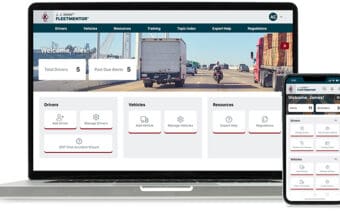
February 24, 2023
GREEN BAY – Though the shipping season is officially done at the Port of Green Bay, Director Dean Haen said preparations are already underway for the next season to begin in just a few weeks.
“The shipping season depends on the weather and ice,” he said. “During low ice years, we stay open longer.”
Haen said the U.S. Coast Guard has the final say when the season opens and closes.
“The end of the season is fluid depending upon ice conditions, economic needs and recreational users of the Bay (of Green Bay),” he said. “The Coast Guard looks at the whole region – from Sturgeon Bay down to the Fox River. This past shipping season was longer than normal, but not the longest ever.”
Haen said the port has a hard opening date of March 15 – meaning it can’t open before that.
“Again, after March 15, it’s a combination of weather/ice conditions and economic need,” he said. “Either Mother Nature will allow us to move ships freely, or if we have an economic need, we can call for icebreaking to open the port. Typically, it’s around mid-March versus sometime in early April.”
Economic impact/reach
According to Haen, about 1.75 million metric tons were moved in and out of the port during the 2022 shipping season.
“It wasn’t a strong shipping year,” he said. “It was our lowest tonnage year in the last 10 years. What that tells you is those industries we serve – manufacturing, agriculture and construction – slowed down. If you look at 2022, we were having a solid year until August – then things slowed down.”
Haen said the port is a good indicator of things to come economically – either positively or negatively.
“We are basically used as a six-month indicator of the economy in Northeast Wisconsin,” he said. “In my estimation, we’re going to start slow again this spring, but then we’ll pick up steam and be the opposite of 2022 – where we started fast and heavy and then slowed down when we got to fall. I think 2023 will be a slower start with a strong finish.”
Haen said the impact of the port, which has 14 terminals along a three-mile stretch of the Fox River, has a “much further reach than most people realize.”
“The port’s service area is as far south as Sheboygan, as far west as Wausau and as far north as the Upper Peninsula of Michigan,” he said. “We could bring in raw materials for manufacturing, agriculture and construction in that area of influence.”
According to the port’s website (portofgreenbay.com), businesses along the three-mile stretch of the Fox River handle dry bulk commodities, such as coal, limestone and salt, bulk liquids like petroleum products, liquid asphalt and tallow and breakbulk commodities, including wood pulp and forest products.

Dean Haen
Additionally, oversized cargo like machinery and wind components also go through the port.
As the westernmost Lake Michigan dock, railroad companies and major trucking firms also utilize the port.
According to the port’s last economic impact document – which was released in 2017 – the port has a $140 million annual impact and supported 1,289 jobs from cargo moving via the marine terminals located at the port.
Of those, 564 jobs were directly generated by the marine cargo and vessel activity at the marine terminals.
As a result of the local and regional purchases by those 564 individuals holding the direct jobs, an additional 404 induced jobs were supported in the regional economy.
Another 321 indirect jobs were supported by $34.7 million of regional purchases by businesses supplying services at the marine terminals at the Port of Green Bay.
Haen said the economic impact study puts a number to something that isn’t easy to measure – the value of shipping and ports to the Badger State.
He said the findings are used to validate the contributions this industry makes, as well as analyze the best future investments we can make to further strengthen the economy and employ even more people in Wisconsin.
Haen said this year, they’ll look at the numbers yet again.
“We’ll be using 2022’s data, so those studies should be completed sometime this fall,” he said.
Port grants announced
Haen said because the port is so important in supporting the economy throughout the region, continued maintenance and improvement is essential – but obviously also expensive.
As of late, the port and two of its terminal operators announced they are receiving $2.4 million in grant funding for harbor maintenance and improvement projects – a welcome contribution by Wisconsin Gov. Tony Evers through Wisconsin’s Harbor Assistance Program.
“This is good news for Green Bay and our entire region,” Haen said. “The port received three grants. Of that, the port received $1 million to stabilize the shoreline at a port development project site at the mouth of the Fox River with bulkhead fill and dock wall construction. In addition, Lafarge, a terminal operator at the port, received $1.2 million to dredge the bed of the Fox River and construct a new docking facility that will receive imports of cement for regional construction projects. Finally, U.S. Venture received $200,000 to do some dredging work to keep their facility up to par.”

Shown here is the Alpena, a ship that visited the Port of Green Bay several times last shipping season. Photo Courtesy of Port of Green Bay
Haen said the port received almost half of the $5.3 million in harbor grants awarded statewide.
“It is recognition of the port’s economic importance,” he said. “We thank Gov. Evers and Wisconsin’s Harbor Assistance Program for the funding. These grant funds will allow the port and our terminal operators to continue working to maintain and improve waterborne transportation that supports and grows our regional and state economy.”
Haen said grants are given competitively, so other ports in the state are also competing for them.
“Port infrastructure can last 75 years, so it’s a sound, long-term investment,” he said.
“These projects have been out there for some time, so you must keep applying and make your case.”
First Ship Contest
With dozens of large ships coming and going in and out of the Port of Green Bay each year, Haen said excitement always builds throughout the area in anticipation of the first ship of the season.
As in years past, the port and Discover Green Bay are sponsoring the First Ship Contest for the upcoming season.
“It’s a fun way for people to guess the opening,” Haen said.
He said ice covering the St. Lawrence Seaway and water conditions in other parts of the Great Lakes play a factor.
“The opening can vary by as much as 30 days,” he said.
The contest asks members of the public to guess the date and time they believe the first ship will arrive in the Port of Green Bay this spring.
The person with the closest guess wins a prize package from Discover Green Bay and the Port of Green Bay.
This year’s prize package for the winner includes:
A one-night stay at St. Brendan’s InnA gift card from The Depot Green BayFour admission tickets to the Neville Public Museum in Green BayA 2023 Big Ships of Green Bay Calendar by Chuck ZentmeyerA 200th anniversary Brown County Monopoly GameA Port of Green Bay swag bag
Haen said shipping season start dates in recent years were March 18 (2022), March 19 (2021), March 15 (2020), April 5 (2019) and March 26 (2018).
Official guesses of this year’s first ship can be registered at greenbay.com/contests/first-ship-contest.
One entry per person is allowed.
If there are multiple correct guesses, the person who submitted their entry first will be chosen as the winner.
 Helping young entrepreneurs discover, build upon the possibilities
Helping young entrepreneurs discover, build upon the possibilities Builds on the past, offers a glimpse into the future
Builds on the past, offers a glimpse into the future








